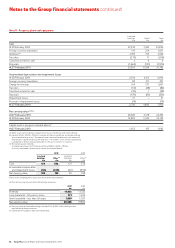Tesco 2010 Annual Report Download - page 104
Download and view the complete annual report
Please find page 104 of the 2010 Tesco annual report below. You can navigate through the pages in the report by either clicking on the pages listed below, or by using the keyword search tool below to find specific information within the annual report.
Notes to the Group financial statements continued
Note 22 Financial instruments
Derivatives are used to hedge exposure to market risks and those that are held as hedging instruments are formally designated as hedges as defined in
IAS 39. Derivatives may qualify as hedges for accounting purposes and the Group’s hedging policies are further described below.
Finance income of £20m (2009 – finance costs of £30m) resulted from hedge ineffectiveness.
Fair value hedges
The Group maintains interest rate and cross-currency swap contracts as fair value hedges of the interest rate and currency risk on fixed rate debt issued
by the Group. Changes in the fair value of derivatives that are designated and qualify as fair value hedges are recorded in the Group Income Statement,
together with any changes in the fair value of the hedged asset or liability that are attributable to the hedged risk. The gain or loss on the hedging
instrument and hedged item is recognised in the Group Income Statement within finance income or costs. If the hedge no longer meets the criteria for
hedge accounting, the adjustment to the carrying value of the hedged item is amortised to the Group Income Statement under the effective interest
rate method.
A loss of £65m on hedging instruments was recognised during the year, offset by a gain of £85m on hedged items (2009 – a gain of £1,197m on hedging
instruments was offset by a loss of £1,227m on hedged items).
Cash flow hedges
The Group uses forward foreign currency contracts to hedge the cost of future purchases of goods for resale, where those purchases are denominated in
a currency other than the functional currency of the purchasing company. Where these contracts qualify for hedge accounting, mark-to-market gains
and losses are deferred in equity.
The hedging instruments are primarily used to hedge purchases in Euros and US Dollars. The cash flows hedged will occur and will affect the Group
Income Statement within one year of the balance sheet date.
When a hedging instrument expires or is sold, or when a hedge no longer meets the criteria for hedge accounting, any cumulative gain or loss existing
in equity at that time remains in equity and is recognised when the forecast transaction is recognised in the Group Income Statement. When a
forecast transaction is no longer expected to occur, the cumulative gain or loss that was reported in equity is immediately transferred to the Group
Income Statement.
Net investment hedges
The Group uses forward foreign currency contracts, currency denominated borrowings and currency swaps to hedge the exposure of a proportion of its
non-Sterling denominated assets against changes in value due to changes in foreign exchange rates.
The Group has a South Korean Won denominated liability relating to the future purchase of the minority shareholding of its subsidiary, Samsung Tesco
Co. Limited. This liability has been designated as a net investment hedge of a proportion of the assets of Samsung Tesco Co. Limited.
Gains and losses accumulated in equity are included in the Group Income Statement on disposal of the overseas operation.
Financial instruments not qualifying for hedge accounting
The Group’s policy is not to use derivatives for trading purposes, however, some derivatives do not qualify for hedge accounting, or are specifically not
designated as a hedge where gains and losses on the hedging instrument and the hedged item offset in the Group Income Statement.
These instruments include caps, interest rate swaps and forward foreign currency contracts. Changes in the fair value of any derivative instruments that
do not qualify for hedge accounting are recognised immediately in the Group Income Statement within finance income or costs.
The Group has a liability relating to the future purchase of the minority shareholding of its subsidiary, dunnhumby Limited. Changes in the value of the
liability are recognised immediately in the Group Income Statement within finance income or costs.
The fair value of derivative financial instruments have been disclosed in the Group Balance Sheet as follows:
2010 2009
Asset Liability Asset Liability
£m £m £m £m
Current 224 (146) 382 (525)
Non-current 1,250 (776) 1,478 (302)
1,474 (922) 1,860 (827)
102 Tesco PLC Annual Report and Financial Statements 2010
























